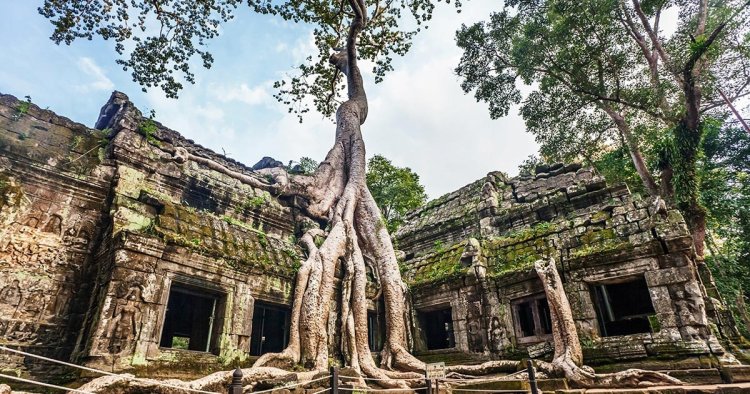The discovery of the Ta Prohm temple in Cambodia
The discovery of the Ta Prohm temple in Cambodia - A place rich in history and extremely suggestive, where you can descend and breathe all the mystical atmosphere of the East in union with the sacred charm of Nature: we are talking about the Ta Prohm temple, part of the Angkor archaeological site, the most important in Cambodia .

The discovery of the Ta Prohm temple in Cambodia
A place rich in history and extremely suggestive, where you can descend and breathe all the mystical atmosphere of the East in union with the sacred charm of Nature: we are talking about the Ta Prohm temple, part of the Angkor archaeological site, the most important in Cambodia .
The dimensions of this archaeological area are impressive: 400 square kilometers, where hundreds of sacred Hindu and Buddhist temples once stood. Today, due to the political events of the country, the jungle and the weather are almost all in ruins, but about eighty still remain standing. These represent a wonderful testimony of the civilization of the Kmer empire, which for about 600 years (802-1431) governed the vast territory that extended from Cambodia to Thailand, Laos and southern Vietnam.
The visitor who enters the archaeological park dating back to the end of the 12th century cannot fail to feel a sense of amazement and bewilderment, such as the first explorers who discovered these remains must have felt.

Merged in embrace with the jungle, the temples here intertwine with huge trees, towers and ancient walls are assaulted by climbing plants, the color of the stones emerges in the dazzling green that surrounds it, demonstrating how ephemeral the glory of men is compared to the strength of nature.
Ta Prohm is the most important temple in the park and in all of Cambodia and has remained in the same condition in which it was found.
It was one of the first temples established by King Jayavarman VII in 1186 AD. and it was part of his grandiose reign program, which involved the construction of many buildings and various public works.
The modern name of the temple means "old Brahma", but the original name was Rajavihara - or "royal temple" - and was dedicated to the veneration of the royal family of the monarch. It is no coincidence that the main image of the temple, which represents Prajnaparamita, the personification of wisdom, was modeled on that of the king's mother, while the two satellite temples in the third enclosure were dedicated to her guru (the one to the north) and his older brother (the one to the south).
Various expansions and additions to the structure continued even later, until the end of the fifteenth century.
On the stele of the temple it is indicated that the site was inhabited by more than 12,000 people, up to 80,000 people if we also consider those who lived in the surrounding villages and it is for this reason that the temple managed to concentrate a large amount of wealth, such as gold, pearls and precious silks.
The basic layout of the temple is the "flat" one of the typical Khmer temple, with five rectangular enclosures around the central shrine.
The outermost wall of 1000 meters by 650, encloses an area that could have easily contained a city, but which today is mainly occupied by forest. There are gopuras, i.e. entrances, at each cardinal point, although today access is only possible from the eastern and western entrances. Each entrance in turn has a tower in the shape of a face, very similar to those of the Bayon temple, also at the Angkor site. In the past, there were also water-filled ditches outside the fourth enclosure.
Unlike other Cambodian temples, Ta Prohm doesn't have many narrative bas-reliefs. One explanation for this is that much of the original artwork of the temple was related to Buddhism and thus it is believed that it may have been destroyed by Hindu iconoclasts after the death of King Jayavarman VII. However, some depictions of scenes from Buddhist mythology still remain visible, such as a badly eroded bas-relief illustrating the "Great Departure" of Siddhartha, the future Buddha, from his father's palace. The temple also features stone reliefs of devatas (minor female deities), monks, meditating ascetics and dvarapalas – so-called temple guardians, armed with spears and staves. Among the remains of the bas-reliefs there is one that seems to resemble a stegosaurus, a dinosaur that lived long before civilization and the temple itself: this is a subject of debate today between those who claim it is a mystery and those who think it is actually a rhinoceros or a wild boar and therefore only a figurative misinterpretation.
It is the trees that grow above the ruins that are the main feature that distinguishes the temple for today's visitor. Ta Prohm was in fact abandoned towards the end of the 15th century, and therefore forgotten, like all the other temples of Angkor. Only in the second half of the 19th century was the city lost in the jungle rediscovered and at the beginning of the 20th century, during the French domination, when the restoration and study of the monuments of Angkor began, the Ecole française d'Extreme–Orient decided to leave Ta Prohm in the same state, or nearly so, in which it was found, as a "concession to the general taste for the picturesque" and because it was "one of the most impressive temples and the one best fused with the jungle, but not yet to the point of becoming part of it".
The state of abandonment of the temple is therefore only apparent: a lot of work has been done to stabilize the ruins and in any case preserve the uniqueness of the place.

















